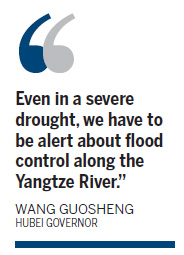Society
Reservoirs have little in reserve
By Li Yao and Zhou Lihua (China Daily)
Updated: 2011-05-24 07:17
 |
Large Medium Small |
Recent rainfall not sufficient to satiate increasing demand
BEIJING - Nearly 1,600 water reservoirs in Central China's Hubei province are running at the minimum water level needed for operation, forecasting a prolonged dry spell over the parched province, the local drought relief authority said on Monday.
As of Sunday, the province's reservoir water storage stood at 9.75 billion cubic meters, a 40-percent decrease from last year. The low water level makes it unlikely the drought can be eased, with two earlier rounds of rainfall but no more forecast in May, the statement said.
The lasting drought has so far affected 889,000 hectares of crops and left 761,000 people and 175,000 livestock in the province short of drinking water.

Hanjiang River, a major branch of the Yangtze River in Hubei, has almost dried up and put a huge strain on irrigation supplies for paddy fields along its range.
The water level of the Danjiangkou Reservoir, part of China's massive South-to-North Water Diversion Project, dropped to 4 meters below the minimum level.
Honghu Lake, the biggest lake in the province, has seen one-fourth of its 35,300-hectare area dry up, stranding thousands of fishing boats. The water level reaches 30 cm in the deepest areas, where it used to stand at two to three meters.
Hubei Governor Wang Guosheng, also chief of the Yangtze River flood control and drought relief headquarters, said on Monday that the river has experienced the lowest level of rainfall since 1961, with 40 to 60 percent less rainfall on average in drought-stricken provinces in its middle and lower reaches including Hubei, Hunan and Jiangxi.
The headquarters' hydrographic office predicts that heavier rainfall over the Yangtze River basin during the flood period (May to October) may increase the flood risk upstream.
"Even in a severe drought, we have to be alert about flood control along the Yangtze River," Wang said.
Chang Xiaolin, a professor at the College of Water Resources and Hydroelectric Engineering of Wuhan University, told China Daily that the situation is due to shrinking amounts of rainfall, while the demand for water - for drinking, irrigation and power generation - is stable or increasing.
The construction of the reservoir system did not take long-term water conservation into consideration. Excessive water collected in one year can't be saved in preparation for possible droughts next year, Chang said.
"But to build bigger reservoirs and enable them to hold a huge amount of water for future use, other factors have to be considered, including submerged land, the evacuation of affected residents and financial costs."
Tighter control over the conversion of lakes and wetland to farmland or commercial use, and better protection of vegetation, will also help enhance the overall capacities and flexibility of water storage to alleviate droughts and floods, he added.
To relieve the devastating drought in the province, the Three Gorges Dam, the largest hydroelectric project in the world, has discharged 17 billion cu m of water to downstream areas since January, and will keep the discharge rate above 11,000 cu m a second from May 25 to June 10.
Xinhua and Guo Rui contributed to this story.